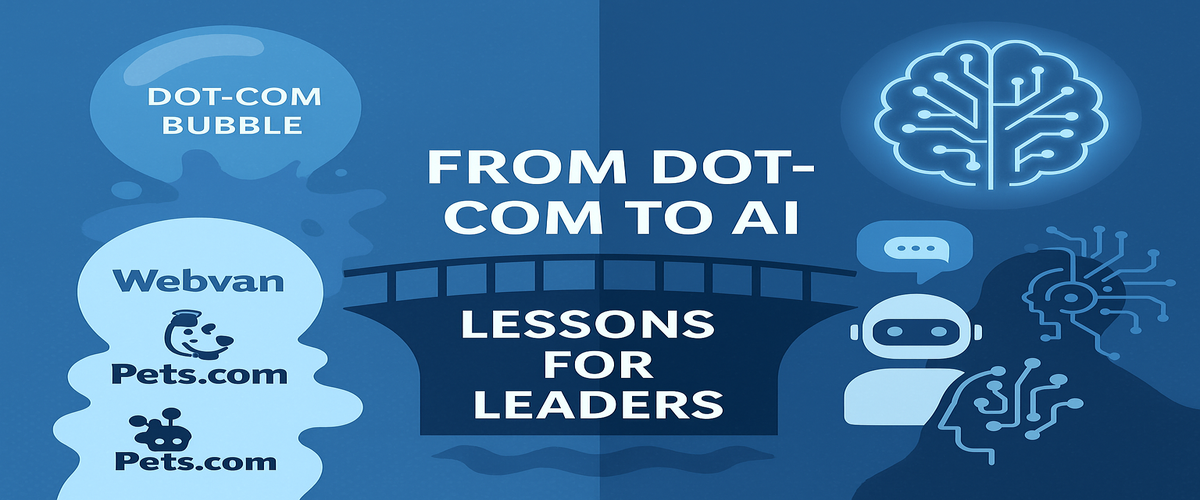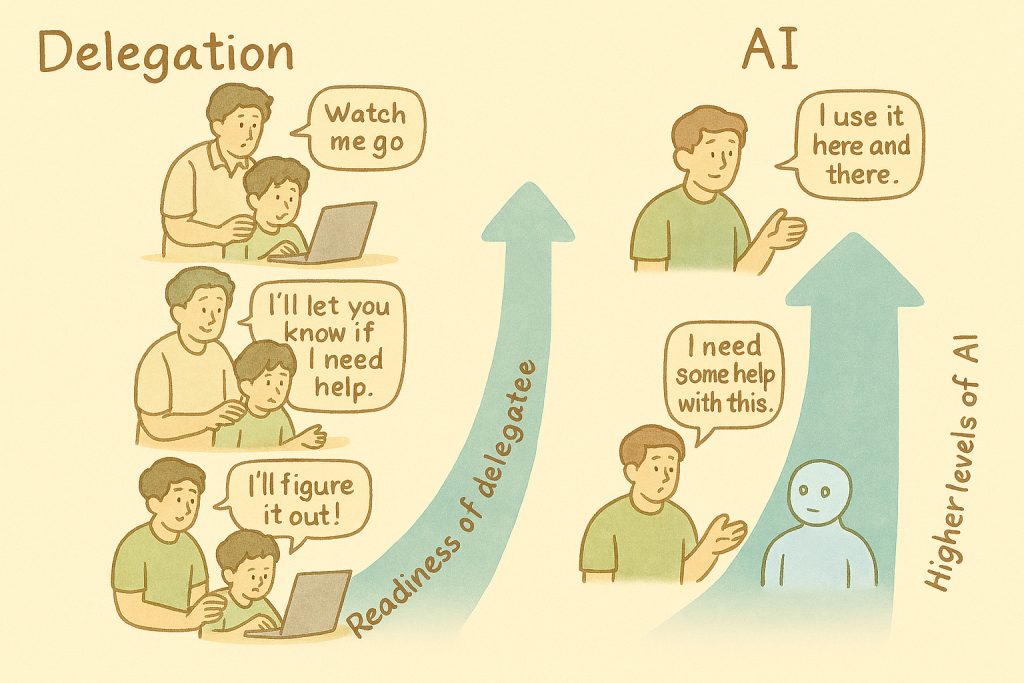Introduction
“History has a way of repeating itself — and those who do not learn from past mistakes are doomed to repeat them.” We’ve seen this across politics, economics, and society — and now, it feels like technology is once again re-experiencing the past.
The late 1990s and early 2000s gave us the dot-com boom: a period of immense hype, staggering investment, and spectacular collapse. Yet, out of that turbulence emerged enduring giants like Amazon, Google, and eBay.
Today, as we witness the rush toward artificial intelligence — particularly generative AI — the parallels are striking. Billions are being poured into pilots and platforms. Every boardroom is racing to announce an AI strategy. And just like in the dot-com era, many will stumble, while a few will emerge stronger than ever.
Are there lessons we can draw from the dot-com bubble to guide AI adoption — helping us avoid painful failures while building long-term value and success? This blog is an attempt to answer that question. We will look at notable failure cases from the dot-com era, explore the parallels with today’s AI adoption, and highlight the key lessons for moving forward.
1. Overinvestment Before Readiness
Dot-com case: Webvan
Webvan set out to revolutionize grocery delivery, raising nearly $800 million in funding and expanding into multiple U.S. cities. But the infrastructure to support such a model simply didn’t exist at the time — logistics networks were immature, consumer demand wasn’t validated, and operational costs ballooned. Within just two years, Webvan collapsed, becoming one of the biggest busts of the dot-com crash.
AI parallel: Air Canada’s chatbot debacle
In 2023, Air Canada faced embarrassment when its customer service chatbot gave misleading information about refund policies. When challenged in court, the airline argued that it wasn’t responsible for what the AI system told customers — but the court disagreed and forced Air Canada to honor the refunds. The incident highlighted that despite investment in a shiny GenAI interface, the airline lacked the data quality, safeguards, and governance to support it reliably.
Lesson for leaders
Don’t confuse enthusiasm for readiness. Both Webvan and Air Canada’s chatbot show what happens when organizations scale prematurely, without the boring but critical foundations in place. For AI adoption, this means prioritizing clean data, robust infrastructure, governance, and workforce skills before rushing into large-scale rollouts. The winners will be those who invest in readiness first and scale second.
2. Inflated Expectations, Followed by Disillusionment
Dot-com case: Pets.com
Perhaps the most infamous failure of the dot-com boom, Pets.com raised nearly $300 million and became a household name with its sock-puppet mascot and splashy Super Bowl ads. The assumption was that a catchy brand and early-mover advantage would guarantee success. But the fundamentals were broken — shipping bulky pet food was expensive, margins were razor-thin, and customer demand was overestimated. Within two years of its IPO, the company shut down.
AI parallel: IBM Watson Health
A decade later, IBM Watson Health promised to revolutionize medicine by diagnosing diseases and recommending treatments. The hype was massive — Watson even starred on Jeopardy! as proof of its intelligence. But when deployed in hospitals, Watson often delivered unreliable results, required excessive manual intervention, and failed to integrate into doctors’ workflows. After years of underperformance, IBM quietly scaled down and sold off Watson Health in 2022.
Lesson for leaders
Hype can burn through millions if not anchored in practical value delivery. Pets.com and Watson Health show how inflated expectations — without attention to feasibility, integration, and ROI — lead to disillusionment. For AI today, leaders must set realistic timelines, accept that early failures are part of the adoption curve, and focus on embedding AI into processes where it can drive sustainable impact.
3. Winners Emerge Slowly but Enduringly
Dot-com case: Amazon & Google
Amid the chaos of thousands of dot-com failures, a few companies quietly focused on fundamentals. Amazon relentlessly invested in logistics and customer experience instead of chasing quick profits. Google built a superior search algorithm that created real, everyday utility. They weren’t the flashiest names during the boom — but over time, they redefined entire industries and became enduring winners.
AI parallel: Netflix, Tesla, and enterprise adopters
In today’s AI boom, a handful of organizations are following a similar path. Netflix has integrated AI deeply into content recommendations, personalizing the user experience in ways competitors struggle to match. Tesla applies AI not as a side project but at the heart of self-driving, manufacturing, and energy systems. Likewise, JPMorgan has used AI to strengthen fraud detection and risk management, embedding it into core operations rather than treating it as an experiment. These organizations treat AI as a strategic capability, not a press-release initiative.
Lesson for leaders
The real winners don’t emerge overnight. They focus on solving meaningful problems, building durable capabilities, and scaling steadily. For AI, the lesson is to resist chasing hype-driven pilots and instead embed AI into areas of the business where it can create sustained advantage. The long game is what counts.
4. From Tech Projects to Business Transformation
Dot-com case: Beyond “just having a website”
In the late 1990s, many firms believed that simply launching a website meant they were “doing e-business.” But the real transformation came when companies reimagined their business models. Dell built a direct-to-consumer online model that reshaped its supply chain. Banks transformed customer service by enabling secure online transactions. Those who went beyond surface-level tech projects unlocked entirely new ways of working.
AI parallel: Novartis and R&D transformation
In the 2010s, Novartis experimented with small AI pilots in drug discovery, but results were modest. The breakthrough came when the company redesigned its R&D operating model to integrate AI at scale. Partnering with Microsoft, Novartis built AI platforms for molecule discovery, reorganized teams, and reskilled scientists. By treating AI not as an add-on but as central to its R&D engine, Novartis significantly accelerated discovery cycles and reduced costs.
Lesson for leaders
Technology alone doesn’t transform businesses — businesses transform themselves using technology. Just as websites became transformative only when integrated into core models, AI will create impact only when it reshapes processes, roles, and decision-making. Leaders must ensure AI adoption isn’t siloed as a “tech initiative,” but woven into the fabric of business transformation.
5. Leadership and Cultural Barriers
Dot-com case: Barnes & Noble vs. Amazon
In the late 1990s, Barnes & Noble treated e-commerce as a secondary channel, bolting a website onto its existing bookstore business without strong leadership focus. By contrast, Amazon’s leadership, starting with Jeff Bezos, made online retail the core of its strategy. The result: Barnes & Noble’s digital efforts stagnated, while Amazon scaled to dominance.
AI parallel: GE vs. Siemens in industrial AI
General Electric (GE) launched its ambitious Predix industrial AI platform with great fanfare, but cultural and leadership missteps held it back. Engineers resisted adoption, leadership struggled to align business units, and the project ultimately underdelivered. In contrast, Siemens embedded AI into its digital twin and automation offerings, with strong leadership backing and integration into core businesses — helping it pull ahead in industrial AI adoption.
Lesson for leaders
Technology alone doesn’t drive transformation — leadership commitment and cultural alignment do. Barnes & Noble and GE illustrate how treating digital or AI projects as bolt-ons leads to stagnation. Amazon and Siemens show that when leaders visibly champion change, align culture, and embed innovation into the business model, adoption accelerates.
Closing Reflection
The dot-com boom taught us that hype cycles eventually burst. Countless companies failed spectacularly, but the underlying technology — the internet — was real, transformative, and enduring. The winners were not those who invested the most money or moved the fastest, but those who invested wisely, built strong foundations, and transformed their business models with clarity of purpose.
The same will be true of AI. The current rush will see its share of inflated promises and painful failures. But AI itself — like the internet before it — is here to stay, with the power to reshape industries, redefine work, and unlock new forms of value.
The organizations that thrive in the long run will be those that:
- Invest in readiness first — data, infrastructure, and skills;
- Calibrate expectations and learn from early failures;
- Play the long game by embedding AI into strategy, not side projects;
- Lead from the top, building cultures of trust and transformation; and
- Innovate responsibly, with ethics and regulatory readiness at the core.
So the real question for leaders is not “Are you experimenting with AI?”
It is: “Are you building the foundations, culture, and foresight to become one of AI’s enduring winners?”




